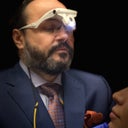Thank you for your question and for sharing your photographs jais1. I understand your concern. Botox is a purified protein used to address wrinkles associated with facial expression. When injected into the skin Botox will relax the muscles and smoothen out the overlying wrinkles. The most common areas of treatment are in the upper face. These include the horizontal lines seen on the upper forehead when one raises the brows, the vertical lines seen between the brows when one frowns (frown lines), and the crow's feet seen around the eyes when one smiles.It is difficult to make an assessment without a formal exam where the entire medical history is reviewed. However, I hope the information provided here is useful.While Botox is most commonly used in the upper faace, it can also be used in various areas in the lower face and neck. Botox can be placed just under the jawline in what is called the Nefertiti lift to relax the platysma muscle which pulls down on the lower face, thereby improving jawline definition. When placed lower in the neck Botox can address vertical neck bands. Approximately 10 units are used below each jaw and in each band.Other areas in the lower face where Botox is used are as follows: The nasalis muscle on the bridge of the nose is responsible for the bunny lines that are sometimes seen there when one frowns or smiles. Usually 2-4 units of Botox are used per side for this area. Botox can be placed in the orbicularis oris muscle around the lips to provide a pout to the lips and reduce the appearance of vertical lines around the lips sometimes called smoker’s lines (although they are seen in people who do not smoke as well). In this area 2-4 units are used above the upper lip and 2 units are used on the lower lip. Botox can be placed in the depressor anguli oris (DAO) muscle to elevate downturned corners of the mouth which sometimes produce a sad face appearance. In this area 2-4 units are used per side. Botox can be placed in the mentalis muscle on the chin to address a cobblestone appearance or dimpling on the chin. In this area 2-8 units of Botox are used. Botox can be placed in the masseter muscle in the lower face to contour the lower face and address pain associated with TMJ. In this area 20-40 units of Botox are used per side. Botox can be placed in the levator labii superioris alequae nasii (LLSAN) muscle located just beside the nose on either side to address what is called the gummy smile. The gummy smile is seen in some people whose upper lip elevates so high when they smile that the upper gums are seen in addition to their upper teeth. In this area 2-4 units are used per side. Botox can be placed in a vestigial muscle (seen in some people) called the depressor septi nasii to prevent the tip of the nose from moving downward when smiling. Here only 1-2 units is required. The safety record of Botox is well established. The product has been used for over 20 years for a variety of treatments with minimal side effects. Botox is amongst the safest treatments for treating facial wrinkles.With any injection, there are risks such as pain, bleeding, bruising, redness, swelling, tenderness, and infection. We take special precautions to minimize these risks such as using a painless technique. We also treat bruises with a laser as early as the next day. Bruises usually resolve within two weeks if untreated. After a laser treatment bruises usually resolve in 1-3 days, but may still take two weeks for full resolution. In addition to these risks, with Botox there is also a risk that the product spreads or diffuses to nearby structures. Spread to nearby muscles can lead to side effects such as the temporary appearance of droopy eyelids or a temporary asymmetric smile.If I had a patient who looked like the person in these photographs I would recommend that she visit a physician at an urgent care clinic.After a Botox treatment, I recommend that my patients avoid heat exposure, alcohol consumption, and strenuous exercise for 24 hours and not lie down flat for four hours. This is because all of these activities may possibly lead to the movement of the product and consequent side effects such as droopy eyelids as described above. Although there have been no definitive studies shown that these actually occur and some physicians do not provide such aftercare instructions, in the absence of data I err on the side of caution and recommend that my patients avoid such activities.Please consult with a doctor for specific recommendations. Good luck!
